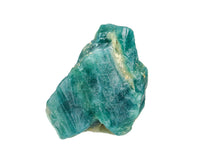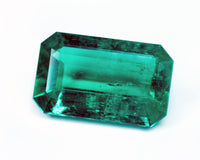- 1. Apatite
- 2. The History of Apatite
- 3. Apatite Properties
- 4. Colors and Varieties of Apatite
- 5. Deposits of Apatite
- 6. Apatite In Jewelry
- 7. The Healing Properties of Apatite
- 8. The Magical Properties of Apatite
- 9. The Value of Apatite
Apatite
Apatite is a phosphate mineral with a reputation as a rogue earned due to its similarity to other gemstones.
Its name comes from the Greek word 'apatao' meaning deception. Because of its color and properties, the stone can be easily confused with topaz, beryl, tourmaline, and other premium minerals.
The trickster stone had been messing with people for quite a long time until scientists finally figured it out and gave it its current name.
The History of Apatite
Despite the fact that apatite is pretty ancient, people had no idea what kind of stone they were dealing with.
As we have already noted, the stone is disguised as other minerals. Only experts could distinguish it from other gems. As you can imagine, gemologists (stone experts) simply did not exist centuries ago.
A German geologist Abraham Werner set things right in 1788 after thoroughly studying the mineral. Although there were attempts to classify the stone before, it was singled out in a separate group only at the end of the 18th century.
Apatite Properties
Apatite is calcium phosphate, a substance found in human and animal bones. However, unlike bone tissue, it is rarely found in its pure form. More often than not, the mineral features inclusions and impurities.

Without these inclusions, it would be transparent and colorless. Magnesium, having penetrated the mineral, gives it a green or blue hue, and a dash of iron adds yellow. Translucent gems with a light pink or purple tint are rare but magnificently beautiful.
On top of that, due to such a phenomenon as chatoyancy, apatite becomes opaque and gets a cat's eye effect.
Many specimens of apatite boast luminescence. If it is irradiated with waves of different lengths, the stone can change its color. Yellow apatites, for example, turn pink in shortwave light, purple ones take on a greenish tint, green apatite acquires a mustard color, and blue stones produce a purple glow.
Colors and Varieties of Apatite
Depending on their chemical composition, apatite stones are divided into three groups:
Fluorapatite contains fluoride. This group is distinguished by a large variety colors. It includes violet, pink, yellow, crimson, and translucent apatites. The most notable is Mexican Yellow apatite, a vibrant and quite common mineral.

Chloropatite stones deliver green, gray, and pinkish hues. Their name speaks for itself as they contain traces of chlorine. Green apatite, due to its light and pure color, received the trade name asparagus apatite.
Hydroxyapatites are a group of white, blue, red, and violet minerals. They contain a great deal of water.
Deposits of Apatite
Apatite is an ancient stone that originated during volcanic eruptions. The gem is widespread throughout the world but each deposit is unique. Apatite mined in a particular country most often has a specific color.
For example, Mexico supplies bright yellow gems. Brazil is well-known for its neon blue apatite deposits. Mines in Italy deliver purple varieties, while Russia provides pink ones.
Myanmar and Brazil are the sources of cat's eyes specimens. Besides that, apatite deposits are located in the USA, Canada, India, Namibia, Madagascar, Sri Lanka, etc. One of the largest yellow-green apatites with a weight of 147 carats was found in Kenya.
Apatite In Jewelry
Apatite isn't a hard stone. On the Mohs scale, it is assigned the level 5, although many specimens are even softer with their 3 and 4 levels. Due to the lack of hardness, the stone is easy to scratch. You can rarely see it in rings and other types of jewelry that require excellent wearability. Jewelry making supply offers apatite cabochon (polished stone) in regular and irregular shapes. Undrilled loose stones lend themselves well for crafting earrings and pendants where the minerals are secured with prongs or glue. Most of the time, beads come pre-drilled to create rosary-like bracelets and necklaces. Apatite is not a stone that can be worn every day. Therefore, save your apatite jewelry for special occasions.

Not only is apatite soft but also brittle. This makes the cutting process very difficult. Difficult but not impossible. The hardest specimens are suitable for cutting, but they must be worn and care for with the utmost care. Apatites are sensitive to heat, shock, and chemicals, especially acidic ones. You should never introduce them to abrasive materials when wearing, storing, or cleaning.
The Healing Properties of Apatite
Lithotherapy experts recommend apatite jewelry to easily excitable and nervous people. The gemstone pacifies and stabilizes the nervous system. It is also used to treat throat and thyroid disorders.
Due to the high content of phosphorus, apatite helps cure such diseases as rickets, scrofula, and bone fragility. Those who suffer from anemia, calcium metabolism disorders, as well as nursing mothers can also benefit from the gem's healing properties. Last but not least, apatites help quickly recover after severe and debilitating illnesses.
The Magical Properties of Apatite
Apatite is an excellent talisman protecting against a variety of ailments, especially those related to the nervous system. The mineral is called the stone of pacification. It goes all out to save its owner from adversity. They say it is able to send prophetic dreams. With the impending danger, apatite causes skin itchiness to warn a person. If you understand the language apatite speaks, you can save yourself from misfortune.
Apatite is an effective talisman for people whose life or career is associated with risk (police, firefighters, rescuers, rangers, etc.). Besides that, it patronizes tourists and travelers.

The Value of Apatite
Apatite belongs to the group of semi-precious stones. Therefore, its price isn’t as expensive as that of its precious counterparts. The value of apatite is determined by several factors such as its translucency, color saturation, and size. Neon blue apatite has one of the highest values around, the same can be said about blue Brazilian stones and purple minerals from Maine.

Faceted apatites are valued higher than polished ones due to the complexity of processing. Nonetheless, impeccably polished stones can boost their value tremendously.
Looking for affordable apatite for sale? Look no further than Kenkengems. We supply a great variety of loose apatites drilled and undrilled, as well as in strands and settings. Our cabochons of all possible sizes and shapes plus faceted gems featuring a great range of colors will help bring your jewelry ideas to life.



